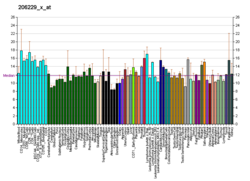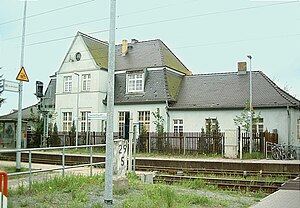PAX2
PAX2PAX2로도 알려진 쌍상자 유전자 2는 PAX2 [5][6]유전자에 의해 인간에게 암호화되는 단백질이다.
기능.
팍스 유전자 또는 유전자를 포함한 쌍상자는 다중 세포주의 발달과 증식, 장기 발달, 중추 신경계의 [7]발달과 구성에 중요한 역할을 한다.전사인자 유전자 Pax2는 중추신경계의 국소배아학적 발달에 중요하다.포유류의 뇌는 전뇌, 중뇌,[8] 후뇌의 세 가지 영역으로 발달한다.섬유아세포 성장인자 8(FGF8)과 윙리스형 MMTV 통합 사이트 패밀리, 멤버 1(Wnt1)의 농도 구배는 간뇌 또는 [9]중뇌의 발달 중 Pax2의 발현을 제어한다.태생학적 발달 중의 유사한 패턴은 "기저 척색체 또는 자낭체"에서 관찰될 수 있으며, 자낭체 유충의 중추신경계 조직 또한 섬유아세포 성장인자에 [8]의해 제어된다.Pax2 유전자는 중뇌와 후뇌 영역의 구성에 필수적인 것으로 보이는 전사 인자를 암호화하며, 운동과 감각 신경 [7][10]핵을 분리하는 설커스 리미탄스의 어느 쪽에서도 가장 빨리 검출될 수 있다.
PAX2는 드로소필라 멜라노가스터 유전자 prd의 많은 인간 상동체 중 하나인 쌍상자 유전자 2를 암호화한다.이 전사인자 유전자 패밀리의 중심 특징은 보존된 DNA 결합 쌍상자 도메인이다.PAX2는 종양억제 유전자 WT1에 의한 전사억제 대상인 것으로 생각된다.Pax 2는 시그널링 분자 Wnt1 및 Fgf8에 의해 제어되는 전사 계수입니다.Pax2는 다른 전사인자 Pax5, Pax8, En1, En2와 함께 중간뇌 영역의 Otx2-Gbx2 경계를 넘어 발현됩니다.이러한 전사인자는 시그널링 분자 Wnt1 및 Fgf8과 연계하여 MHB 오거나이저를 유지합니다.MHB는 중뇌와 소뇌의 발달을 조절한다.Pax2는 Otx2-Gbx2 경계를 넘어 발현된 가장 이른 유전자이다.이것은 후기 원시 줄무늬 단계에서 처음 발현되며 체질 형성 중에 MHB를 중심으로 한 좁은 고리로 발현된다.중힌드뇌와 발달 중인 신장의 트랜스젠 발현이 Pax2에 의해 지시된다.Pax2의 업스트림지역에는 3개의 MHB 고유의 인핸서가 있습니다.4소마이트 단계 이후 MHB에서의 발현은 Pax2의 근위부 및 원위부 영역에 있는 2개의 후기 인핸서에 의해 지시된다.중간 영역에 위치한 초기 강화제는 후기 위배아의 뇌 중간 영역을 활성화시킵니다.Pax2, Pax5, Pax8의 활성화는 모든 척추동물의 보존된 특징이다.
임상적 의의
병리학적으로 Pax2는 간세포증식인자(HGF) 유전자 프로모터를 활성화하는 것으로 입증되었으며, 둘 다 인간 전립선암에 [11]관여하는 것으로 나타났다.
PAX2 내의 돌연변이는 시신경콜로종과 신장저형성을 초래하는 것으로 나타났다.이 유전자의 대체 스플라이싱은 다중 전사 [12]변형을 일으킨다.또한 Pax2와 Pax8은 프로플롭스와 후속 신장 구조의 형성에 필요하다.Pax2 및 Pax8은 Gata3의 발현을 규제한다.이러한 유전자가 없으면 비뇨기계의 돌연변이가 발생한다.
팍스2 양성 우울증은 신장의 증식 장애에서 자주 관찰된다.예를 들어 Pax2는 다낭성 신장질환(PKD), 윌름스 종양(WT), 신장세포암(RCC)[13]에서 많이 발현된다.이러한 질병에서 Pax2 발현은 연료전지 순환으로 나타나 세포사멸을 억제하고 [13]화학요법에 대한 내성을 부여한다.Pax2는 이러한 질병에서의 역할로 인해 매력적인 치료 대상이며, 그 활성을 억제하기 위한 여러 가지 방법이 연구되어 왔다.사실, 작은 분자는 최근 [14][15]Pax2가 DNA에 결합하는 것을 차단함으로써 Pax2 매개 전사를 방해할 수 있는 능력을 가진 것으로 확인되었다.
상호 작용
PAX2는 PAXIP1과 [16]대화하는 것으로 나타났습니다.
「 」를 참조해 주세요.
레퍼런스
- ^ a b c GRCh38: 앙상블 릴리즈 89: ENSG000075891 - 앙상블, 2017년 5월
- ^ a b c GRCm38: 앙상블 릴리즈 89: ENSMUSG00000004231 - 앙상블, 2017년 5월
- ^ "Human PubMed Reference:". National Center for Biotechnology Information, U.S. National Library of Medicine.
- ^ "Mouse PubMed Reference:". National Center for Biotechnology Information, U.S. National Library of Medicine.
- ^ Pilz AJ, Povey S, Gruss P, Abbott CM (1993). "Mapping of the human homologs of the murine paired-box-containing genes". Mammalian Genome. 4 (2): 78–82. doi:10.1007/BF00290430. PMID 8431641. S2CID 30845070.
- ^ Stapleton P, Weith A, Urbánek P, Kozmik Z, Busslinger M (Apr 1993). "Chromosomal localization of seven PAX genes and cloning of a novel family member, PAX-9". Nature Genetics. 3 (4): 292–8. doi:10.1038/ng0493-292. PMID 7981748. S2CID 21338655.
- ^ a b Mansouri A, Gruss P (2013). "Pax Gene". In Hughes K, Maloy K (eds.). Brenner's Encyclopedia of Genetics (2nd ed.). San Diego: Elsevier Science. pp. 246–248. doi:10.1016/B978-0-12-374984-0.01128-1. ISBN 978-0-08-096156-9.
- ^ a b Imai KS, Satoh N, Satou Y (2002). "Region specific gene expressions in the central nervous system of the ascidian embryo". Mechanisms of Development. 119 Suppl 1: S275–7. doi:10.1016/S0925-4773(03)00128-X. PMID 14516697. S2CID 16714343.
- ^ WNT1용 GeneCard
- ^ Nolte J (2009). The human brain: an introduction to its functional anatomy (6th ed.). Philadelphia, PA: Mosby/Elsevier. p. 685. ISBN 978-0-323-04131-7.
- ^ Ueda T, Ito S, Shiraishi T, Taniguchi H, Kayukawa N, Nakanishi H, et al. (2015). "PAX2 promoted prostate cancer cell invasion through transcriptional regulation of HGF in an in vitro model". Biochimica et Biophysica Acta (BBA) - Molecular Basis of Disease. 1852 (11): 2467–73. doi:10.1016/j.bbadis.2015.08.008. PMID 26296757.
- ^ "Entrez Gene: PAX2 paired box gene 2".
- ^ a b Sharma R, Sanchez-Ferras O, Bouchard M (2015). "Pax genes in renal development, disease and regeneration". Seminars in Cell and Developmental Biology. 44: 97–106. doi:10.1016/j.semcdb.2015.09.016. PMID 26410163.
- ^ Grimley E, Liao C, Ranghini E, Nikolovska-Coleska Z, Dressler G (2017). "Inhibition of Pax2 Transcription Activation with a Small Molecule that Targets the DNA Binding Domain". ACS Chemical Biology. 12 (3): 724–734. doi:10.1021/acschembio.6b00782. PMC 5761330. PMID 28094913.
- ^ Grimley E, Dressler GR (2018). "Are Pax proteins potential therapeutic targets in kidney disease and cancer?". Kidney International. 94 (2): 259–267. doi:10.1016/j.kint.2018.01.025. PMC 6054895. PMID 29685496.
- ^ Lechner MS, Levitan I, Dressler GR (Jul 2000). "PTIP, a novel BRCT domain-containing protein interacts with Pax2 and is associated with active chromatin". Nucleic Acids Research. 28 (14): 2741–51. doi:10.1093/nar/28.14.2741. PMC 102659. PMID 10908331.
추가 정보
- Noll M (Aug 1993). "Evolution and role of Pax genes". Current Opinion in Genetics & Development. 3 (4): 595–605. doi:10.1016/0959-437X(93)90095-7. PMID 8241771.
- Dahl E, Koseki H, Balling R (Sep 1997). "Pax genes and organogenesis". BioEssays. 19 (9): 755–65. doi:10.1002/bies.950190905. PMID 9297966. S2CID 23755557.
- Eccles MR, He S, Legge M, Kumar R, Fox J, Zhou C, French M, Tsai RW (2003). "PAX genes in development and disease: the role of PAX2 in urogenital tract development". The International Journal of Developmental Biology. 46 (4): 535–44. PMID 12141441.
- Eccles MR, Wallis LJ, Fidler AE, Spurr NK, Goodfellow PJ, Reeve AE (May 1992). "Expression of the PAX2 gene in human fetal kidney and Wilms' tumor". Cell Growth & Differentiation. 3 (5): 279–89. PMID 1378753.
- Sanyanusin P, Schimmenti LA, McNoe LA, Ward TA, Pierpont ME, Sullivan MJ, Dobyns WB, Eccles MR (Apr 1995). "Mutation of the PAX2 gene in a family with optic nerve colobomas, renal anomalies and vesicoureteral reflux". Nature Genetics. 9 (4): 358–64. doi:10.1038/ng0495-358. PMID 7795640. S2CID 29180124.
- Ward TA, Nebel A, Reeve AE, Eccles MR (Sep 1994). "Alternative messenger RNA forms and open reading frames within an additional conserved region of the human PAX-2 gene". Cell Growth & Differentiation. 5 (9): 1015–21. PMID 7819127.
- Stapleton P, Weith A, Urbánek P, Kozmik Z, Busslinger M (Apr 1993). "Chromosomal localization of seven PAX genes and cloning of a novel family member, PAX-9". Nature Genetics. 3 (4): 292–8. doi:10.1038/ng0493-292. PMID 7981748. S2CID 21338655.
- Pilz AJ, Povey S, Gruss P, Abbott CM (1993). "Mapping of the human homologs of the murine paired-box-containing genes". Mammalian Genome. 4 (2): 78–82. doi:10.1007/BF00290430. PMID 8431641. S2CID 30845070.
- Sanyanusin P, McNoe LA, Sullivan MJ, Weaver RG, Eccles MR (Nov 1995). "Mutation of PAX2 in two siblings with renal-coloboma syndrome". Human Molecular Genetics. 4 (11): 2183–4. doi:10.1093/hmg/4.11.2183. PMID 8589702.
- Sanyanusin P, Norrish JH, Ward TA, Nebel A, McNoe LA, Eccles MR (Jul 1996). "Genomic structure of the human PAX2 gene". Genomics. 35 (1): 258–61. doi:10.1006/geno.1996.0350. PMID 8661132.
- Dehbi M, Ghahremani M, Lechner M, Dressler G, Pelletier J (Aug 1996). "The paired-box transcription factor, PAX2, positively modulates expression of the Wilms' tumor suppressor gene (WT1)". Oncogene. 13 (3): 447–53. PMID 8760285.
- Bonaldo MF, Lennon G, Soares MB (Sep 1996). "Normalization and subtraction: two approaches to facilitate gene discovery". Genome Research. 6 (9): 791–806. doi:10.1101/gr.6.9.791. PMID 8889548.
- Schimmenti LA, Cunliffe HE, McNoe LA, Ward TA, French MC, Shim HH, Zhang YH, Proesmans W, Leys A, Byerly KA, Braddock SR, Masuno M, Imaizumi K, Devriendt K, Eccles MR (Apr 1997). "Further delineation of renal-coloboma syndrome in patients with extreme variability of phenotype and identical PAX2 mutations". American Journal of Human Genetics. 60 (4): 869–78. PMC 1712484. PMID 9106533.
- Narahara K, Baker E, Ito S, Yokoyama Y, Yu S, Hewitt D, Sutherland GR, Eccles MR, Richards RI (Mar 1997). "Localisation of a 10q breakpoint within the PAX2 gene in a patient with a de novo t(10;13) translocation and optic nerve coloboma-renal disease". Journal of Medical Genetics. 34 (3): 213–6. doi:10.1136/jmg.34.3.213. PMC 1050895. PMID 9132492.
- Tavassoli K, Rüger W, Horst J (Dec 1997). "Alternative splicing in PAX2 generates a new reading frame and an extended conserved coding region at the carboxy terminus". Human Genetics. 101 (3): 371–5. doi:10.1007/s004390050644. PMID 9439670. S2CID 43590139.
- Stayner CK, Cunliffe HE, Ward TA, Eccles MR (Sep 1998). "Cloning and characterization of the human PAX2 promoter". The Journal of Biological Chemistry. 273 (39): 25472–9. doi:10.1074/jbc.273.39.25472. PMID 9738017.
- Devriendt K, Matthijs G, Van Damme B, Van Caesbroeck D, Eccles M, Vanrenterghem Y, Fryns JP, Leys A (Aug 1998). "Missense mutation and hexanucleotide duplication in the PAX2 gene in two unrelated families with renal-coloboma syndrome (MIM 120330)". Human Genetics. 103 (2): 149–53. doi:10.1007/s004390050798. PMID 9760197. S2CID 8930257.
- Schimmenti LA, Shim HH, Wirtschafter JD, Panzarino VA, Kashtan CE, Kirkpatrick SJ, Wargowski DS, France TD, Michel E, Dobyns WB (2000). "Homonucleotide expansion and contraction mutations of PAX2 and inclusion of Chiari 1 malformation as part of renal-coloboma syndrome". Human Mutation. 14 (5): 369–76. doi:10.1002/(SICI)1098-1004(199911)14:5<369::AID-HUMU2>3.0.CO;2-E. PMID 10533062.
외부 링크
- 신콜로보마증후군에 대한 유전자 리뷰/NCBI/NIH/UW 엔트리
- 미국 국립의학도서관의 PAX2+단백질+인간 의학 주제 제목(MeSH)
이 기사에는 미국 국립 의학 도서관(미국 국립 의학 도서관)의 공공 도메인 텍스트가 포함되어 있습니다.











